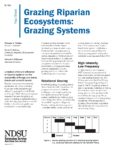The educational materials listed on this page are about Rangeland/Pasture Management.
There is no one specific pasture definition because of how diverse farming systems look and operate, but pasture management is a critical concern for grazing lands, especially on rangeland and open range management systems. So, what is rangeland? Rangeland management includes the health, riparian area condition, fisheries habitat, water quality, and threatened and endangered species within the system being managed. This is one reason why the definition of pasture or the rangeland definition may be complex and diverse. Cattle may heavily graze areas with gentle terrain near water instead of rugged terrain or areas far from water, thus making rangeland ecology and management critical. The key to resolving such problems is to critically think about pasture management systems and to implement practices that protect rangeland ecology. This is one suggestion for what can be done to sustain the productivity of rangeland and improve rangeland pasture management. Key practices include holistic management, grazing management, rotational grazing, stocking rate, rangeland pasture management, range improvement, pasture renovation, watering systems.
The Rangeland Management Strategies bulletin provides information regarding multi-species grazing and winter grazing, and offers advice to manage forage and vegetation, and protect riparian areas on farms. Diversifying Cropping Systems is a bulletin that can be useful in identifying practices that enhance diversity on farms, thus improving rangeland pasture management. Smart Water Use on your Farm or Ranch can be used to better understand the role of water in a farm system and in pasture management or riparian protection. SARE’s book Building Soils for Better Crops provides examples of soil management practices to improve pasture resiliency in grazing systems.
Showing 1-1 of 1 results

Maintenance of Natural Sustainable Riparian Communities Fact Sheets Series
A graduate student from North Dakota State University created these five extension fact sheets after monitoring and reporting on the riparian ecosystem associated with the Middle Sheyenne River, a perennial stream in eastern North Dakota.